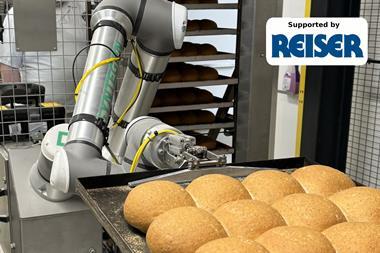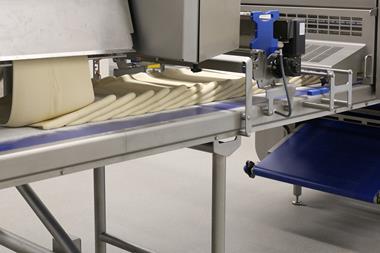Bakers cannot afford to ignore the condition of their bakeware, but getting the right coatings for tins and using the correct release agents for different products is no straightforward process.
Tins are the unsung heroes of baked goods production. They pass quietly (well, fairly quietly) along production lines and through in-store bakeries in their millions, getting on with the job.
But bakers ignore the condition of their tins at their peril, and worn or dirty bakeware can seriously impact the quality of baked goods and the production process.
One element that can extend the life of a tin, reduce the need to prematurely clean equipment, and pay significant dividends
in terms of efficiency, is the use of the correct release agent.
Some release agents are best suited
for tins and trays that have to withstand high temperatures in the oven, for
example, while others are used for the greasing of dough dividers, bowls, chutes and hoppers.
When it comes to making a selection, the type of product being manufactured is a key factor to consider, advises Richard Hazeldine, national sales manager of ingredients supplier Zeelandia.
The recipe will be a major influence, as fat and sugar content determine the dough’s adhesion to the baking surface.
Breads benefit from a liquid release agent, suggests Bakels marketing manager Michael Schofield, while sweet confectionery goods with a higher sugar content would benefit from a higher viscosity release agent to ensure smooth release. The Bakels range, for example, includes Tinglide, a paste which is supplied n pails and can be applied by brush for the production of cake and sponge goods, and the Sprink liquid agent available in aerosol cans.
The shelf life of the final product can also influence choice, as long shelf-life products or products that may be frozen need release agents with good resistance to oxidation to prevent any residual release agent going rancid.
Just as important in the selection process is the baking surface – the shape of the equipment, whether it has corners and whether or not it is solid or has perforations, for example.
If depositing batter on to a sheet you may need to control the flow of the batter to ensure that products are uniform in size.
One factor often overlooked when choosing a release agent is the method of application, adds Hazeldine.
“The key to good release is the right product coupled with the right application method,” he says. “Most release agents work best when applied sparingly, particularly those with high lubricating and release power.”
For industrial bakers, pumpable solutions are best suited to integrate the release agent into the automatic dosing systems required to maximise efficiency on high-volume baked goods batches.
Bakers should ensure spray patterns are maintained and that the release agent is evenly sprayed into the tin.
It is also important to ensure spray timings are optimised, so that the release agent is sprayed into the tin and not
across the top of the strap. Passing greased empty straps or trays through the oven
can accelerate carbon build-up and should be avoided.
Over time the tin coating will gradually deteriorate, and it may be necessary to slightly increase the amount of release agent being used.
For businesses that opt to recoat tins, it is important to remember to reduce the amount of release agent back to the previous level afterwards, advises Hazeldine. For this reason, it is always worth recoating a full set of tins as those that are most worn will determine the required level of release agent.
Bakery tins still await revolutionary breakthrough
Tins have been part of the baking landscape for hundreds of years – as has the challenge of preventing products from sticking to them.
Back in the 17th century, for example, bakers used buttered paper to stop their wares sticking to a tin. Four hundred years later and bakers now coat trays with varying quantities of release agents before baking.
Yet, compared to other areas of food production, bakery tins and sheets have not seen the sort of leap in technology that could slash costs and bring smarter production on a grand scale. No one has yet come up with a perfect way of cleaning trays, and experimental long-life tin projects have not come to anything, says bakery consultant John Haynes, director of JRH Associates.
The problem is that there is not enough profit in tins to fund the research needed to support a revolution, he says.
But there has been progress, Haynes points out, such as the introduction of aerosol sprays for spraying release agents onto cake tins.
“The aerosol technology for release agents has been around a long time,” he says. “It originated in pizza parlours and moved on into the bread market and is now used in cakes.”
Another advance has been improvement in the coatings of tins and trays, allowing smaller quantities of release agents to be used. This can both reduce ingredient costs as well as the cost of labour required to spray the tins before filling.
Haynes says: “Bakeries want to eliminate emulsions if possible, and by using modern coatings, you only have to introduce sprays as the tins get older.”
Trays and tins also have to be recoated less often, he adds.
Another innovation is the use of RFID tags on tins, to track them through the baking process – particularly useful in in-store bakeries where release agents are avoided, and trays need to be sent off for cleaning and recoating.
One such system is Kaak Group’s iBakeware, which launched in 2015. Each tin or group of tins has a tag giving them a unique identity. The tin (and therefore the product in it) can then be tracked around the bakery in real time. Data can be stored, giving direct historical information relating to tin coating life and other ‘events’ that may occur that relate to bakeware performance. Damaged and worn straps are automatically removed from production.


























No comments yet